Servicios Personalizados
Revista
Articulo
Indicadores
-
 Citado por SciELO
Citado por SciELO -
 Accesos
Accesos
Links relacionados
-
 Similares en
SciELO
Similares en
SciELO
Compartir
Revista mexicana de ciencias geológicas
versión On-line ISSN 2007-2902versión impresa ISSN 1026-8774
Rev. mex. cienc. geol vol.27 no.1 Ciudad de México abr. 2010
The species of genus Chasicotatus Scillato–Yané (Eutatini, Dasypodidae)
Las especies del género Chasicotatus Scillato–Yané (Eutatini, Dasypodidae)
Gustavo Juan Scillato–Yané1, Cecilia Mariana Krmpotic1,*, and Graciela Irene Esteban2
1 Consejo Nacional de Investigaciones Científicas y Técnicas. División Paleontología de Vertebrados, Museo de La Plata, Paseo del Bosque s/n, 1900, La Plata, Argentina. *E–mail: ckrmpotic_pv@fcnym.unlp.edu.ar.
2 Instituto Superior de Correlación Geológica (INSUGEO), Facultad de Ciencias Naturales e Instituto Miguel Lillo, Miguel Lillo 205, 4000, San Miguel de Tucumán, Argentina.
Manuscript received: October 7, 2009.
Corrected manuscript received: November 30, 2009.
Manuscript accepted: December 12, 2009.
ABSTRACT
Chasicotatus was originally described as a monotypic genus based on Chasicotatus ameghinoi Scillato–Yané, 1979, from the upper member of Arroyo Chasicó Formation (Las Barrancas Member, late Chasicoan). An additional species, Chasicotatus peiranoi , was erected by Esteban and Nasif (1996). This work presents the description of two new species previously recognized but never published by Scillato–Yané (1982), with a study and description of the osteoderm's internal structure from three of four species of the genus. On this basis, the genus is revised and expanded diagnoses are provided for the previously known taxa, so that the species are clearly differentiated by internal and external osteodermal features. The geographical distribution of the species of genus Chasicotatus supports advanced palaeoenvironmental hypotheses previously proposed by different authors.
Key words: Xenarthra, Eutatini, Chasicotatus, systematic, palaeohistology, Arroyo Chasicó Formation, Argentina.
RESUMEN
Chasicotatus fue reconocido como un género monotípico, con Chasicotatus ameghinoi Scillato–Yané, 1979, procedente del miembro superior de la Formación Arroyo Chasicó (Miembro Las Barrancas, Chasiquense tardío). Además, posteriormente fue fundada la especie Chasicotatus peiranoi por Esteban y Nasif (1996). En este trabajo se describen dos especies nuevas, previamente reconocidas pero no publicadas por Scillato–Yané (1982) y se desarrolla un estudio y descripción de la estructura interna de los osteodermos de tres de las cuatro especies del género. Sobre esta base se realiza una revisión del género y se amplían las diagnosis de los taxones previamente conocidos, quedando las especies claramente diferenciadas por caracteres externos e internos de los osteodermos. La distribución geográfica de las especies del género Chasicotatus, avala las hipótesis paleoambientales planteadas previamente por distintos autores.
Palabras clave: Xenarthra, Eutatini, Chasicotatus, sistemática, paleohistología, Formación Arroyo Chasicó, Argentina.
INTRODUCTION
The tribe Eutatini, included in the subfamily Euphractinae (Scillato–Yané, 1980, 1982; McKenna and Bell, 1997), comprises exclusively extinct taxa. This is one of the best represented dasypodid tribes in the stratigraphic units of the Cenozoic in southernmost South America, very frequently found in Argentina (Scillato–Yané, 1980; Scillato–Yané et al., 1995) and to a lesser extent in Uruguay (Mones and Francis, 1973; Mones, 1986; Perea–Negreira, 1998; Bostelmann et al., 2008), Chile (Croft et al., 2007) and Bolivia (Croft et al., 2009). In contrast, they have not been recorded in southern Brazil, even though other faunal elements typical of the Pleistocene of the Pampean Region are abundant in that area.
The eutatines had one of the most extreme southern distribution ranges among dasypodids (Stenotatus Ameghino, 1891a and Proeutatus Ameghino 1891b, south of Santa Cruz province) and they evolved the most abundant hair of any dasypodid, probably in connection with the adaptation to colder climates (Scillato–Yané et al., 1995; Carlini et al., 2005). They are recorded in since the Casamayoran (Barrancan, late Eocene) to Platan (early Holocene). At the locality Gran Barranca Sur, near Colhue–Huapi Lake (Chubut province, Argentina), the diversity and abundance of Eutatini shows a remarkable increase from the Tinguirirican (Carlini et al., 2004, 2005, 2009).
From late Miocene to early Holocene, the eutatines are represented by the following genera: Chasicotatus (Chasicoan–Huayquerian), Doellotatus Bordas, 1932 (Huayquerian–Vorohuean), Ringueletia Reig, 1958 (Huayquerian–Barrancalobian) and Eutatus Gervais, 1867 (Chapadmalalan–Platan). Eutatus has the largest geographical range in Argentina and is also the taxon most frequent found, followed by Chasicotatus. At present, the records for the tribe in Uruguay comprise the genera Eutatus, Doellotatus and Ringueletia (Mones and Francis, 1973; Perea–Negreira, 1998; Bostelmann et al., 2008).
Chasicotatus was originally recognized as a monotypic genus: Chasicotatus ameghinoi Scillato–Yané, 1979, from the upper (Las Barrancas Member) of the Arroyo Chasicó Formation (late Chasicoan). In his doctoral thesis, Scillato–Yané (1982) recognized two new species, which are only now being published as part of the present work. Later on, another species was erected for northwestern Argentina (Catamarca province), namely Chasicotatus peiranoi Esteban and Nasif, 1996, which was later recorded in the southwest of Buenos Aires province (Deschamps, 2005). Likewise, the species Chasicotatus ameghinoi was also recorded in the provinces of Catamarca (Esteban and Nasif, 1999) and La Pampa (Esteban et al., 2001, 2003; Urrutia, 2004, Urrutia et al., 2008).
This work provides a revision of the genus and the description of two new species, which were originally recognized by Scillato–Yané (1982), but not subsequently published. In addition, the morphology and the internal structure of osteoderms from three of four species of the genus Chasicotatus is studied in comparison with other Eutatini studied previously.
ABBREVIATIONS
MLP: División de Paleontología de Vertebrados, Facultad de Ciencias Naturales y Museo de La Plata, Universidad Nacional de La Plata.
PVL: Paleontología Vertebrados Lillo, Facultad de Ciencias Naturales e Instituto Miguel Lillo, Universidad Nacional de Tucumán.
UNSGH: Cátedra de Geología, Universidad Nacional de Sur, Bahía Blanca.
MATERIALS AND METHODS
Materials
Chasicotatus ameghinoi . Holotype: MLP 76–VI–12–11. Hypodigm: holotype and MLP 28–X–11–43, 28–X–11–64, 30–XII–10–13, 55–IV–28–47, 60–VI–18–67, 60–VI–18–75, 76–VI–12–19, 76–VI–12–26, 76–VI–12–27, 76–VI–12–38, 76–VI–12–58, 76–VI–12–111, 76–VI–12–136, 76–VI–12–137. Chasicotatus peiranoi . Holotype: PVL 4796. Hypodigm: the holotype and UNSGH 57. Chasicotatus powelli n. sp. Holotype: PVL 3212. Paratype: PVL 3213. Chasicotatus spinozai n. sp. Holotype: MLP 69–VIII–4–5.
Methods
Practically no endoskeletal remains are known for the genus Chasicotatus. Because of this, the species of this genus have been erected on the basis of variations in the morphological features from the caparace (of the single fairly complete specimen) and articulated or isolated osteoderms. In this work the internal structure of the osteoderms was investigated in order to conduct as thorough as possible an analysis of the previously existing taxa and one of the new species erected here.
Osteoderms were cleaned with 100 volume hydrogen peroxide as 1:10 dilution in distilled water to remove the sediment lodged in pores, foramina and cavities. They were subsequently embedded in colored polyester resin and placed in a vacuum chamber to ensure complete perfusion of the resin. Once the resin solidified, the pieces were progressively ground using a disc metallographic grinder. Digital photographs were taken every 200 μ (on average) between grinding stages. The observations were compared with the results of previous histological and palaeohistological works.
The internal structure of mobile osteoderms was only studied in C. ameghinoi because the very few complete mobile osteoderms known for C. powelli n.sp. and C. peiranoi could not be used for palaeohistological sections, and in the case of C. spinozoai n. sp., no osteoderms from that region are preserved. Fixed osteoderms of C. spinozai n. sp. were not studied because only two of these are known.
PALAEOHISTOLOGY
Internal morphology of Chasicotatus osteoderms
Palaeohistological sections were made from a mobile osteoderm belonging to Chasicotatus ameghinoi and fixed osteoderms from C. ameghinoi, C. peiranoi and C. powelli n. sp. Morphologically diverse cavities were recognized. In order to make inferences about the type of soft tissues that originally occupied these cavities, they were compared with histological sections from living individuals described in the literature (Fernández, 1931; Krmpotic et al., 2005, 2009a; Hill, 2006; Vickaryous and Hall, 2006; Ciancio et al., 2007), in an attempt to recognize homologous structures (Figure 1).

The osteoderms of Chasicotatus show three well–defined zones, in particular a very well developed middle zone (Figure 1) that seems to be typical of the Euphractinae, since it occurs in Chaetophractus villosus (Desmarest, 1804) Fitzinger, 1871 (Fernández, 1931; Krmpotic et al., 2005, 2009a) and in several eutatine genera, but not in Dasypus Linné, 1758 (Dasypodinae) (Hill, 2006; Ciancio et al., 2007). The Eutatini are hypothesized to have a more developed piliary apparatus compared with the Euphractini, as indicated by the genera Eutatus (Krmpotic et al., 2007a, 2007b, 2009a, 2009b), Ringueletia (Krmpotic et al., 2007c), Sadypus Ameghino, 1902 and Meteutatus Ameghino, 1902 (Ciancio and Carlini, 2007), Doellotatus, Stenotatus (Deseadan, late Oligocene–Colloncuran, early middle Miocene) and Chasicotatus in the present work. The greater piliary development is inferred not only from the number of superimposed hair follicles on each palaeohistological section , but also from the extension and total volume occupied by each hair follicle within the osteoderm (Figure 1).
Chasicotatus ameghinoi
The mobile osteoderms of C. ameghinoi (Figure 2) have a proportionally less developed middle zone when compared with Doellotatus chapadmalensis Bordas, 1933 (Figure 3), and are more similar to Stenotatus patagonicus (Ameghino, 1887) Scott, 1903–1905 (Figure 4). The glandular cavities are smaller than those of Doellotatus chapadmalensis, much smaller than those of Stenotatus patagonicus, never more than two per palaeohistological section and with narrow ducts (one duct per glandular cavity). The hair follicle cavities (like the glandular cavities) are located on the posterior half of the ornamented part; the cranial portion (overlapping region) has a middle zone with large cavities that contain adipose tissue, and the outer and inner zones are proportionally thicker than in Doellotatus chapadmalensis and Ringueletia simpsoni (Bordas, 1933) Reig 1958, similar to those of S. patagonicus. The fixed osteoderms of C. ameghinoi (Figure 5) have large glandular cavities, larger than those of C. peiranoi (Figure 6), but smaller than those of C. powelli n. sp. (Figure 7), never more than two per palaeohistological section; the gland ducts are narrow (one per glandular cavity). The hair follicle cavities are well developed and lodged in a zone that is thicker than the rest of the osteoderm. Analysis of its internal structure shows that this greater thickness is due to the large size of the cavities corresponding to hair follicles and to the presence of a relatively thicker outer zone (Figure 5).
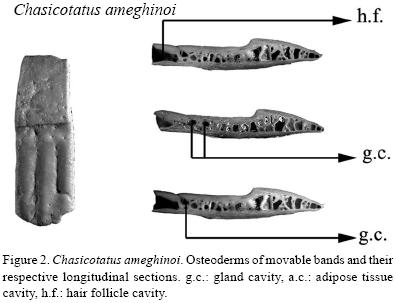
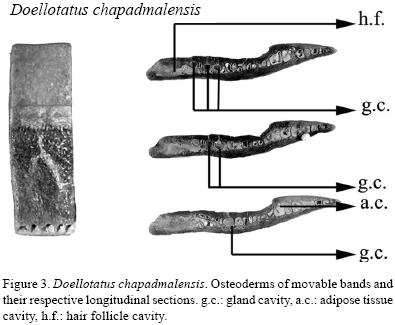
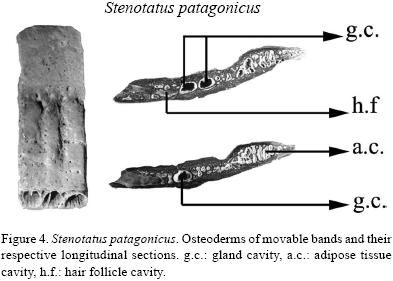
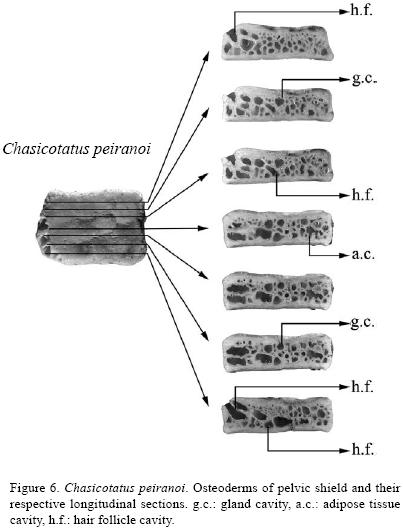
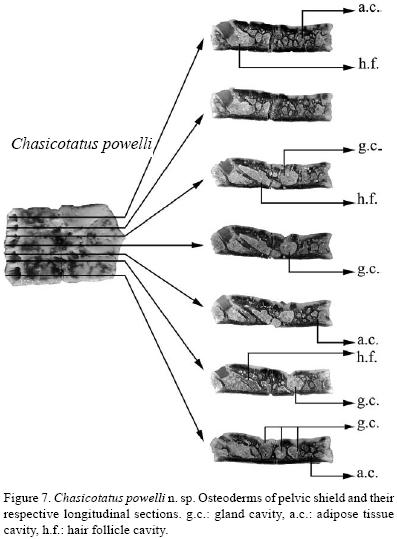
Chasicotatus peiranoi
The fixed osteoderms of C. peiranoi (Figure 6) have better developed inner and outer zones than those of C. powelli n. sp., similar to those of C. ameghinoi, and the middle zone is more developed than in the above mentioned species. The glandular cavities are smaller than those of C. ameghinoi and much smaller than those of C. powelli n. sp. They are distributed in the upper half of the thickness of the middle zone, each with a single duct. In the zones where a second row of hair follicles is visible externally, the internal structure shows that these are divided by a bony septum along their entire length.
Chasicotatus powelli n. sp.
The internal structure of the fixed osteoderms shows the inner and outer zones are thinner than those of C. ameghinoi and C. peiranoi (Figure 7). The glandular cavities are large, larger than those of C. ameghinoi; they may even occupy the entire thickness of the middle zone reaching the inner zone, and possess a single duct. Up to three gland cavities are present per cross–section (unlike the condition in C. ameghinoi and C. peiranoi that have only two).
SYSTEMATIC PALEONTOLOGY
Superorder Xenarthra Cope, 1889
Order Cingulata Illiger, 1811
Superfamily Dasypodoidea Gray, 1821
Family Dasypodidae Gray, 1821
Subfamily Euphractinae Pocock, 1924
Tribe Eutatini Bordas, 1933
Genus Chasicotatus Scillato–Yané, 1979
Type species. Chasicotatus ameghinoi Scillato–Yané, 1979.
Included species. Chasicotatus peiranoi Esteban and Nasif, 1996; Chasicotatus powelli n. sp., this paper; Chasicotatus spinozai n. sp., this paper.
Amended diagnosis (Scillato–Yané, 1979). Small size, intermediate between that of Zaedyus Ameghino, 1889 and Doellotatus. Osteoderms smooth, not rugose. Mobile osteoderms with a smooth region separating the cranial portion from the caudal portion, and ornamentation similar to that of fixed osteoderms, but without anterior figures; margin posterior to hair foramina much less extended than in Eutatus. Fixed osteoderms with central figure more elongated than in Eutatus and with sharp tips, surrounded by two anterior and two lateral figures at each side; figures globose, separated by deep sulci. Internal structure with up to three superimposed hair follicle cavities per palaeohistological section; conspicuous glandular cavities with narrow gland ducts, one per glandular cavity.
Chronological and stratigraphical distribution. Late Miocene (early Chasicoan–late Huayquerian).
Geographical distribution. Argentina (Buenos Aires, La Pampa, Catamarca and Entre Ríos provinces) (Figure 8).
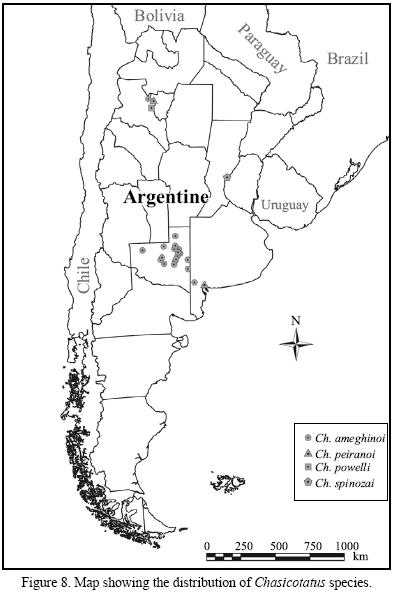
Chasicotatus ameghinoi Scillato–Yané, 1979
Holotype. Large portion of the carapace.
Repository. MLP 76–VI–12–11 (Figure 9). Provenance: Chasicó creek, Villarino Department (Partido), Buenos Aires province; Arroyo Chasicó Formation, Las Barrancas Member (late Chasicoan, late Miocene).
Hypodigm. The holotype and MLP: 28–X–11–43, 28–X–11–64, 30–XII–10–13, 55–IV–28–47, 60–VI–18–67, 60–VI–18–75, 76–VI–12–19, 76–VI–12–26, 76–VI–12–27, 76–VI–12–38, 76–VI–12–58, 76–VI–12–111, 76–VI–12–136, 76–VI–12–137.
Amended diagnosis (Scillato–Yané, 1982). Small size, slightly smaller than that of the remaining species of the genus. Pelvic shield proportionally smaller than in Stenotatus, Doellotatus, and Eutatus. Posterior end of mobile and fixed osteoderms with large hair foramina arranged mediolaterally in a single row as in C. powelli n. sp. Mobile osteoderms with margin posterior to hair foramina more extended than in the other species. Fixed osteoderms with central figure shaped like a narrow elevated keel, both central and peripheral figures more globose than in C. powelli n. sp. and C. peiranoi ; foramina on exposed surface (glandular foramina) as fine punctuations, as in C. peiranoi ; osteoderms thicker posteriorly. Internally the mobile osteoderms have a less developed middle zone than those of Doellotatus chapadmalensis; glandular cavities small, never more than two per palaeohistological section and with narrow ducts (one per glandular cavity), hair follicle cavities (as the glandular cavities) located on the posterior half of the ornamented part and no more than two per palaeohistological section, cranial (overlapping region) portion with thick inner and outer zones, unlike the species of Doellotatus chapadmalensis. Fixed osteoderms with large glandular cavities, larger than those of C. peiranoi , but smaller than those of Chasicotatus powelli n. sp., never more than two per palaeohistological section; well developed hair follicle cavities, lodged in a zone thicker than the rest of the osteoderm.
Chronological and stratigraphic distribution. Late Miocene (early Chasicoan–late Huayquerian).
Geographical distribution. Argentina (Buenos Aires, La Pampa, and Catamarca provinces) (Figure 8).
Chasicotatus peiranoi Esteban and Nasif, 1996
Holotype. 77 fixed osteoderms, five complete mobile osteoderms (11 with missing cranial portion) and numerous fragments of both types, all from a single specimen.
Repository. PVL 4796. Provenance: Valle del Cajón, Department of Santa María, Catamarca province, Subsequences IIb and IIc Playa del Zorro Alloformation, Huayquerian, late Miocene.
Hypodigm. The holotype and UNSGH 57.
Amended diagnosis (Esteban and Nasif, 1996). A Chasicotatus species slightly larger than C. ameghinoi, similar in size to C. powelli n. sp and C. spinozai n sp. Posterior end of the most osteoderms with a double row of hair foramina arranged mediolaterally, the anterior one with 2–4 smaller foramina, and the posterior one with 4 to 5 foramina. Compared with those of C. ameghinoi, the mobile osteoderms are the same length but wider, and they are slightly shorter and broader compared to those of C. powelli n. sp.; central figures oval, with sharp tips, unlike those of C. ameghinoi (not sharp cornered). Fixed osteoderms with central figure broad, sharpened at its tips, less so than in C. ameghinoi and C. spinozai n. sp.; less convex than in C. ameghinoi. Internally, the inner and outer zones of the osteoderm are more developed than in C. powelli n. sp., similar to those of C. ameghinoi; glandular cavities smaller than those of C. ameghinoi and much smaller than those of C. powelli n. sp., arranged in the upper half of the thickness of the middle zone; in those areas where a second row of hair foramina is evident externally, the internal structure shows that these are divided by a bony septum along their entire length.
Chronological and stratigraphic distribution. Late Miocene (Huayquerian).
Geographical distribution. Argentina (Catamarca and Buenos Aires provinces) (Figure 8).
Chasicotatus powelli n. sp.
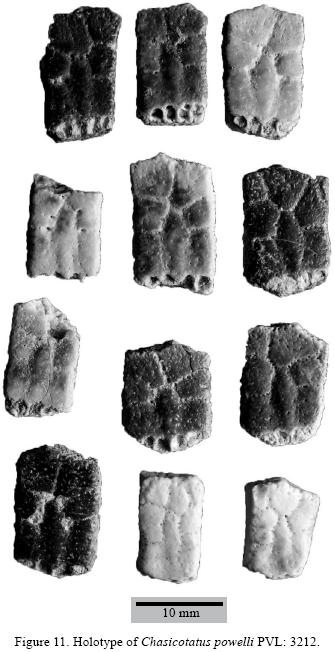
Holotype. 155 fixed osteoderms from the pelvic shield, some of them incomplete, and 20 mobile osteoderms, almost all very fragmented.
Repository. PVL 3212. Provenance: south from El Molle, El Cajón Valley, Santa María Department, Catamarca province; Huayquerian, late Miocene.
Paratype. 32 fixed osteoderms from the pelvic shield and left astragalus, same provenance.
Repository. PVL 3213.
Hypodigm. The holotype and paratype.
Derivatio nominis. In honor of palaeontologist Dr. Jaime Powell.
Amended diagnosis (Scillato– Yané, 1982). Size slightly larger than that of C. ameghinoi, similar to that of C. peiranoi . Astragalus with fused ectal and sustentacular facets, as in Eutatus. Posterior end of mobile and fixed osteoderms with large hair foramina arranged mediolaterally in a single row, as in C. ameghinoi; foramina on exposed surface more conspicuous than in the remaining species of the genus, sometimes extending to the sulci that separate peripheral figures from each other. Central figure of mobile osteoderms flatter, narrower and with shallower delimiting sulci than in C. ameghinoi. Fixed osteoderms with subelliptical central figure, less narrow anteriorly and posteriorly than in C. ameghinoi, similar to that of C. peiranoi ; delimiting sulcus shallower than in the remaining species. Internally, the inner and outer zones are thinner than those of C. ameghinoi and C. peiranoi ; large glandular cavities, larger than those of C. ameghinoi; they may even occupy the entire thickness of the middle zone and contact the inner zone; up to three glandular cavities per section (unlike C. ameghinoi and C. peiranoi , which have only two).
Chronological and stratigraphic distribution. Late Miocene (Huayquerian).
Geographical distribution. Argentina (Catamarca province) (Figure 8).
Chasicotatus spinozai n. sp.
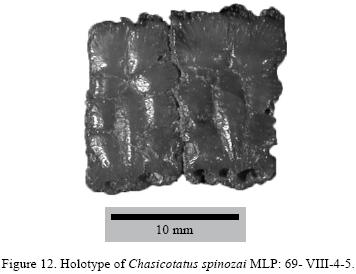
Derivatio nominis. In honor of Dutch–Jewish philosopher Baruch de Spinoza (1632–1677).
Holotype. Two articulated osteoderms from the pelvic shield. Repository. MLP 69–VIII–4–5. Provenance: Vicinity of Paraná, Entre Ríos Province, "Ossiferous Conglomerate" of Ituzaingó Formation, Huayquerian Age, late Miocene.
Amended diagnosis (Scillato– Yané, 1982). Size similar to that of C. powelli n. sp. and C. peiranoi . Fixed osteoderms proportionally longer than those of C. ameghinoi. Central figure of fixed osteoderms forming a keel narrower and more prominent than in the remaining species. Sulci delimiting central and peripheral figures deep, more so than in C. powelli n. sp. and C. peiranoi and slightly less so than in C. ameghinoi. Hair follicle foramina much smaller than in the remaining species of the genus. Very noticeable foramina, probably for hair follicles, on both lateral margins of the osteoderms. The foramina on the exposed surface appear as fine punctuations, as in C. ameghinoi and C. peiranoi .
Chronological and stratigraphic distribution. Huayquerian.
Geographical distribution. Argentina (Entre Ríos province).
GEOGRAPHIC AND STRATIGRAPHIC PROVENANCE OF CHASICOTATUS SPECIES
Pampean region
As previously mentioned, Chasicotatus ameghinoi was originally collected from the Arroyo Chasicó Formation, Las Barrancas Member, in the southwest of Buenos Aires province, in sediments assignable to the late Miocene. Bondesio et al. (1980) combined the information about the geology of the area with the data provided by fossil mammal findings and divided the Arroyo Chasicó Formation into two members: Vivero Member and Las Barrancas Member. Fidalgo and Porro (in Bondesio et al., 1980) stated that the sediments of Las Barrancas Member are sandier and less compact than those of the Vivero Member, although both are generally similar. Within this biostratigraphic scheme, these two members are associated with two different biozones: (1) Chasicotherium rothi Biozone (Tonni et al., 1998; Cione et al., 2000), which is the local representative of the Viveran (early Chasicoan), and (2) Chasicotatus ameghinoi Biozone (Tonni et al., 1998; Cione et al., 2000) which represents the Barrancan (late Chasicoan). Both units were deposited during the earliest part of the late Miocene (Tonni et al., 1998). Zárate et al. (2007) made a geological study of the Chasicoan (late Miocene) deposits, recognizing different lithofacies and paleosoils. These authors' lithofacial proposal does not support the lithostratigraphical separation of Arroyo Chasicó Formation into two members.
Later, C. ameghinoi was reported from the Cerro Azul Formation of Chasicoan–Huayquerian age (late Miocene; Verzi, 1999; Verzi et al., 2003, 2004; Montalvo et al., 2005; Verzi et al., 2008). This Formation outcrops mainly in eastern La Pampa province and western Buenos Aires province (as "Epecuén formation" sensu Pascual, 1961; see Linares et al., 1980 and Goin et al., 2000). The lithological similarity between the deposits of Cerro Azul Formation and those of Arroyo Chasicó Formation is very high, and they can only be distinguished when the Río Negro Formation occurs between them (Linares et al., 1980). The first localities of Cerro Azul Formation that yielded remains of Chasicotatus ameghinoi were Telén, Quehué, Loventué, Naicó, Salinas de Hidalgo, Laguna Chillhué, Bajo Giuliani and El Guanaco (Esteban et al., 2001), although additional remains were later found in the localities Caleufú (Esteban et al., 2003) and Cerro La Bota (Urrutia, 2004), all within La Pampa province. According to the most recent biostratigraphic scheme presented by Verzi et al. (2008), Chasicotatus ameghinoi was recorded in the following Biozones: Chasichimys bonaerense, Chasichimys scagliai, Xenodontomys simpsoni and X. elongatus. Thus, the biochron of the species in this formation extends from the early Chasicoan to the late Huayquerian (early late Miocene), and for this reason Verzi et al. (2008) suggested that the old Chasicotatus ameghinoi Biozone be changed, since it would not be an exclusive taxon.
Chasicotatus peiranoi was recorded in the southwest of Buenos Aires province, at the Relleno Sanitario quarry (5 km southeast from Bahía Blanca, near the Grünbein township), with late Huayquerian (late Miocene) age (Deschamps, 2005).
Northwestern Argentine
Chasicotatus powelli n. sp. and Chasicotatus peiranoi come from El Cajón valley (Catamarca province). In this area, the Tertiary is represented by an assemblage of continental sediments that were originally described and named as El Bolsón Group (Turner, 1973); in particular, the fossil–bearing strata corresponds to the El Morterito Formation (Turner, 1973). Bossi et al. (1993) studied the sedimentology of the Neogene in this valley and established a new stratigraphic scheme based on alloformations. Within this scheme, the El Monterito Formation would approximately correspond to sequence II of Playa del Zorro Alloformation (Bossi et al., 1993). Stratigraphically, the Chasicotatus peiranoi remains come from the sequences IIb and IIc of the latter Alloformation (Esteban and Nasif, 1996). In turn, these sequences would correspond to the Andalhuala Formation, in the Santa María Valley (Catamarca province, Bossi et al., 1993), of Huayquerian Age.
Subsequently, Esteban and Nasif (1999) reported remains of Chasicotatus ameghinoi from the "A" Member of the Chiquimil Formation, belonging to the Santa María Group, at the locality Villavil (Catamarca province), which would be upper Chasicoan (Barrancan) in age.
Mesopotamia
As previously mentioned, the remains of Chasicotatus spinozai n. sp. come from the "Mesopotamian" (Ituzaingó Formation) of the vicinity of Paraná, Entre Ríos province. The outcroppings of the Ituzaingó Formation extend from the homonymous city (in Corrientes province) to the north of Paraná city (Entre Ríos province), along the steep bluffs of the Paraná River and several tributary rivers and creeks (Cione et al., 2000; Herbst, 2000; Brandoni, 2005). De Alba (1953) established the type locality of the Ituzaingó Formation in the vicinity of the town of Ituzaingó. The fossil vertebrate remains come almost exclusively from the lower levels of that formation, in particular from the basal stratum informally known as "Mesopotamian" or "ossiferous conglomerate" (Frenguelli, 1920, see Cione et al., 2000), which outcrops discontinuously along the Paraná river bluffs, from the vicinity of the homonymous city in the south, to the locality Pueblo Brugo in the north (Brandoni, 2005). Cione et al. (2000), on the basis of the vertebrate remains found in the "ossiferous conglomerate" and the existing stratigraphic relationships, proposed a greater affinity with the Huayquerian Age (Tortonian of the International scale), although part of the materials collected could suggest a Chasicoan Age. As in the case of the osteoderms of Chasicotatus spinozai n. sp., most of the collections from Paraná lack accurate provenance; however, practically all the terrestrial and freshwater vertebrates come from the "ossiferous conglomerate", at the base of the Ituzaingó Formation (Cione et al., 2000). In turn, Herbst (2000) considers that the base of the Ituzaingó Formation is middle–upper Pliocene in age, but it must be taken into account that this author's studies and chronological hypotheses were made for the area of Corrientes, not for Entre Ríos where these fossil vertebrates were found.
DISCUSSION
The geographic distribution of Chasicotatus is restricted to Argentina, and its chronological range is limited to the early Chasicoan–late Huayquerian (late Miocene). The diverse species are recorded in northwestern Argentina (Catamarca province), Mesopotamia (Entre Ríos province) and the Pampean region (Buenos Aires and La Pampa provinces) (Figure 8).
The internal morphology of osteoderms belonging to the different Chasicotatus species is characterized by the presence of glandular cavities of considerable size with very narrow ducts, one per glandular cavity. Within the internal morphological variations exhibited by the different species, it is noteworthy that the osteoderms of Chasicotatus ameghinoi are most similar to those of Stenotatus patagonicus (Figure 13). The fixed osteoderms of both species are thicker at the posterior area due to the implantation of hair follicles and the great depth of the outer zone of compact bone. However, the glandular cavities of Stenotatus patagonicus are much larger than those of C. ameghinoi, with a double duct, and present hair follicles arranged both vertically and horizontally, whereas the hair follicles of genus Chasicotatus are always arranged obliquely. On the other hand, the internal morphology of Chasicotatus powelli n. sp. resembles that of Doellotatus chapadmalensis in the thickness of the inner and outer zones and in the possession of up to three glandular cavities per palaeohistological section; however, the cavities of Chasicotatus powelli n. sp. are larger than those of Doellotatus chapadmalensis (Figure 14) and have a single duct per glandular cavity. Of the three Chasicotatus species, Chasicotatus peiranoi shows the greatest differences compared to the other two species in terms of internal morphology, due to the great development of its middle zone, smaller size of the glandular cavities and arrangement of hair follicles.
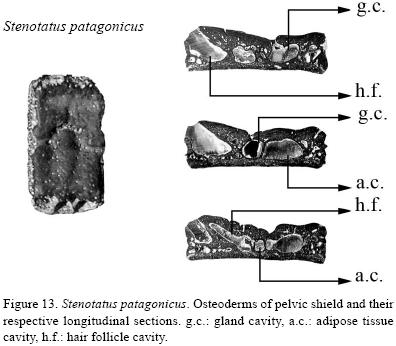
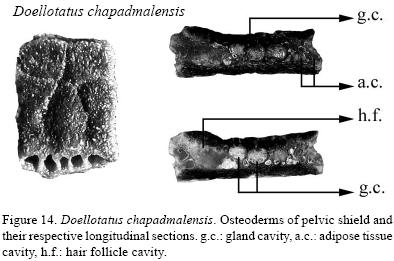
CONCLUSIONS
Two new species of this genus are described. These species are characterized using both the traditional criteria based on the external morphology of the osteoderms, and in addition, for the first time for this taxon, palaeohistological sections of the osteoderms were made allowing observation of numerous internal details (glandular cisterns, ducts that connect them to the exterior, insertion of hairs on the posterior margin, etc.).
A major faunal change took place between the pre–Chasicoan and Chasicoan units, and this change is particularly significant in the case of the Xenarthra Cingulata (Scillato–Yané and Carlini, 1998). Among the Dasypodidae, all the Eutatini and almost all the "pansantacrucian" Euphractini disappeared in the Chasicoan (Scillato–Yané et al., 1993). For the Eutatini, this change includes the definitive disappearance of Stenotatus and Proeutatus from the fossil record, and the first appearance of Chasicotatus.
The geographical distribution of the species of Chasicotatus agrees with the hypothesis for the existence of open habitats during the late Miocene–Pliocene time interval. These habitats would have allowed ample connection between the different geographical regions (Pascual and Bondesio, 1982). Thus, Chasicotatus ameghinoi is recorded in the provinces of Buenos Aires (Chasicoan–Huayquerian), La Pampa (Huayquerian) and Catamarca (Chasicoan). Chasicotatus peiranoi is recorded first in the Huayquerian of Catamarca, and is later recognized in Buenos Aires province. On the other hand, during the late Miocene, the records of diverse vertebrates provide evidence for the occurrence of different regional environments between the extended plains, which anticipates the current biogeographical regions (Pascual, 1984). For instance, toward the end of the Southern Plains period, the southern half of the current Argentine territory was divided into two biogeographical units, parallel to each other: one along the east flank of the Andean mountain range and the other more eastwards, along the pre–Paraná river (Ortiz–Jaureguizar and Cladera, 2006). In general, among the terrestrial vertebrates of the "ossiferous conglomerate" of Ituzaingó Formation, the xenarthrans and notoungulates indicate that the Mesopotamian area was biogeographically distinct from the Pampean region and from Northwestern Argentina (Scillato–Yané, 1975; Cione et al., 2000). In the area of Paraná, gallery forests seem to have predominated (Cione et al., 2000). In this context, only one species of Eutatini is recorded in the "ossiferous conglomerate" (Chasicotatus spinozai n. sp.), and is restricted to that region. This latter species differs from the other three Chasicotatus species by its osteoderm ornamentation, particularly by the presence of hair follicle foramina much smaller than those of the other species of Chasicotatus, which could partly reflect the adaptation of this species to warmer climates.
ACKNOWLEDGEMENTS
The authors wish to express their gratitude to Dr. M. A. Reguero, curator of the División de Paleontología Vertebrados, MLP, and Dr. J. E. Powell curator of Palentología Vertebrados Lillo, PVL. To A. A. Carlini for his reviews and helpful suggestions. H. Gregory McDonald and an anonymous reviewer greatly improved the original manuscript through their critical review.
REFERENCES
Ameghino, F., 1887, Enumeración sistemática de las especies de mamíferos fósiles coleccionados por Carlos Ameghino en los terrenos eocenos de Patagonia Austral y depositados en el Museo de La Plata: Boletín del Museo de La Plata, 1, 1–26. [ Links ]
Ameghino, F., 1889, Contribución al conocimiento de los mamíferos fósiles de la República Argentina: Actas de la Academia Nacional de Ciencias de Córdoba, 6, 1–1028 y Atlas: 98 láms. [ Links ]
Ameghino, F., 1891a, Mamíferos y aves fósiles argentinos. Especies nuevas, adiciones y correcciones: Revista Argentina de Historia Natural, 1, 240–259. [ Links ]
Ameghino, F., 1891b, Nuevos restos de mamíferos fósiles descubiertos por Carlos Ameghino en el Eoceno inferior de Patagonia Austral. Especies nuevas, adiciones y correcciones: Revista Argentina de Historia Natural, 1, 289–237. [ Links ]
Ameghino, F., 1902, Notices préliminaires sur des mammifères nouveaux des terrains crétacés de Patagonie: Boletín de la Academia Nacional de Ciencias de Córdoba, 17, 5–70. [ Links ]
Bondesio, P., Laza, J.H., Scillato–Yané, G.J., Tonni, E.P., Vucetich, M.G., 1980, Estado actual del conocimiento de los vertebrados de la Formación Arroyo Chasicó (Plioceno temprano) de la provincia de Buenos Aires, in II Congreso Argentino de Paleontología y Bioestratigrafía y I Congreso Latinoamericano de Paleontología, Buenos Aires, Argentina: Actas, 3, 101–127. [ Links ]
Bordas, A.F., 1932, Proposición de un nuevo género para Eutatus inornatus: Physis, 11(38), 167–168. [ Links ]
Bordas, A.F., 1933, Notas sobre los Eutatinae. Nueva subfamilia extinguida de Dasypodidae: Anales del Museo Nacional de Historia Natural, 37, 583–614. [ Links ]
Bossi, G.E., Muruaga, C.M, Hernando, A., Ahumada, A.L., 1993, Geología y estratigrafía de la cuenca neógena Santa María–Hualfín (deptos. Santa María y Belén, provincia de Catamarca), in 12° Congreso Geológico Argentino y 2° Congreso de Exploración de Hidrocarburos, Mendoza Argentina: Actas, 2, 156–165. [ Links ]
Bostelmann, E., Rinderknecht, A., Lecuona, G., 2008, Los Eutatini (Mammalia, Dasypodidae) del Uruguay, in III Congreso Latinoamericano de Paleontología, Neuquén, Argentina: Actas, p. 28. [ Links ]
Brandoni, D., 2005, Los Megatheriinae (Xenarthra, Tardigrada) de la Formación Ituzaingó (Mioceno Superior–Plioceno) de la provincia de Entre Ríos: Instituto Superior de Correlación Geológica (INSUGEO), Miscelánea, 14, 27–35. [ Links ]
Carlini, A.A., Ciancio, M.R., Scillato–Yané, G.J., 2004, La transición Eoceno–Oligoceno y su manifestación en la diversidad de los Cingulata (Mammalia, Xenarthra). Inferencias paleoecológicas: Ameghiniana, 41(4), Suplemento, 23–24. [ Links ]
Carlini, A.A., Ciancio, M.R., Scillato–Yané, G.J., 2005, Los Xenarthra de Gran Barranca, más de 20 Ma de historia, in XVI Congreso Geológico Argentino, La Plata, Buenos Aires, Argentina: Actas, IV, 419–424. [ Links ]
Carlini, A.A., Ciancio, M.R., Flynn, J.J., Scillato–Yané, G.J., Wyss, A.R., 2009, The phylogenetic and biostratigraphic significance of new armadillos (Mammalia, Xenarthra, Dasypodidae, Euphractinae) from the Tinguirirican (Early Oligocene) of Chile: Journal of Systematic Palaeontology, 7(4), 489–503. [ Links ]
Ciancio, M.R., Carlini, A.A., 2007, Morfología del sistema pilífero en Eutatinos (Xentarhra, Dasypodidae) del Oligoceno de Patagonia, in III Congreso de Mastozoología, Santa Cruz de la Sierra, Bolivia: Resúmenes, p. 49. [ Links ]
Ciancio, M.R., Krmpotic, C.M., Carlini, A.A., Barbeito, C. 2007, Morfología interna de los osteodermos Dasypodinae y Eupractinae (Xenarthra, Dasypodidae), in III Congreso de Mastozoología, Santa Cruz de la Sierra, Bolivia: Resúmenes p. 50. [ Links ]
Cione, A.L., Azpelicueta, M.M., Bond, M., Carlini, A. A., Casciotta, J., Cozzuol, M., de la Fuente, M., Gasparini, Z., Goin, F.J., Noriega, J.I., Scillato–Yané, G.J., Soibelzon, L., Tonni, E.P., Verzi, D.H., Vucetich, M.G, 2000, Miocene Vertebrates from Paraná, Eastern Argentina: Instituto Superior de Correlación Geológica (INSUGEO), Serie Correlación Geológica, 14, 191–237. [ Links ]
Cope, E.D., 1889, The Edentata of North America: American Naturalist, 23, 657–664. [ Links ]
Croft, D.A., Flynn, J.J., Wyss, A.R, 2007, A new basal Glytodontid and the other taxa Xenarthra of the early Miocene Chucal fauna, Northern Chile: Journal of Vertebrate Paleontology, 27(4), 781–197. [ Links ]
Croft, D.A., Anaya, F., Auerbach, D., Garzione, C., MacFadden, B.J., 2009, New data on Miocene Neotropical Provinciality from Cerdas, Bolivia: Journal of Mammal Evolution, 16, 175–198. [ Links ]
De Alba, E., 1953, Geología del Alto Paraná, en relación con los trabajos de derrocamiento entre Ituzaingó y Posadas: Revista Asociación Geológica Argentina, 8(3), 129–161. [ Links ]
Deschamps, C.M., 2005, Late Cenozoic mammal bio–chronostratigraphy in southwestern Buenos Aires Province, Argentina: Ameghiniana, 42(4), 733–750. [ Links ]
Desmarest, A.G., 1804, Nouveau dictionnaire d'Histoire naturelle: Paris, Chez Deterville, Tome 24, 1–577. [ Links ]
Esteban, G.I., Nasif, N.L., 1996, Nuevos Dasypodidae (Mammalia, Xenarthra) del Mioceno Tardío del Valle del Cajón, Catamarca, Argentina: Ameghiniana, 33(3), 327–334. [ Links ]
Esteban, G.I., Nasif, N.L., 1999, Mamíferos fósiles de la formación Chiquimil (Mioceno tardío), provincia de Catamarca, Argentina. Bioestratigrafía: Ameghiniana, 36, Suplemento, p. 11. [ Links ]
Esteban, G.I., Nasif, N.L., Montalvo, C.I., 2001, Nuevos registros de Dasypodidae (Xenarthra) del Mioceno tardío de la provincia de La Pampa, Argentina: Revista Española de Paleontología, 16(1), 77–87. [ Links ]
Esteban, G.I., Nasif, N.L, Montalvo, C.I., Visconti, G., 2003, Nuevos registros de Dasypodidae (Xenarthra) en la Formación Cerro Azul (Mioceno tardío) de Caleufú, La Pampa, Argentina: Ameghiniana, 40(3), 495–499. [ Links ]
Fernández M., 1931, Sobre la anatomía microscópica y embriología de la coraza de Dasypus villosus: Actas de la Academia Nacional de Ciencias de la Republica Argentina, Tomo X, 61– 121. [ Links ]
Fitzinger, L.J., 1871, Die natürliche Familie der Gürteltiere (Dasypodes): Sitzungsberichte Mathematisch–Naturwissenschaftliche Klasse der Akademie der Wissenschaften, Wien, 64, 209–276, 329–390. [ Links ]
Frenguelli, J., 1920, Contribución al conocimiento de la geología de Entre Ríos: Boletín de la Academia Nacional de Ciencias de Córdoba, 24, 55–256. [ Links ]
Gervais, P., 1867, Sur une nouvelle colection d'ossementes fossiles de Mammifères recueillé par M. Fr. Seguin dans la Conféderation Argentine: Comptes rendus des séances de l' Académie des Sciences, Paris, 65, 279–282. [ Links ]
Goin, F.J., Montalvo, C.I., Visconti, G., 2000, Los Marsupiales (Mammalia) del Mioceno Superior de la Formación Cerro Azul (Provincia de La Pampa, Argentina): Estudios Geológicos, 56, 101–126. [ Links ]
Gray, J.E., 1821, On the natural arrangement of vertebrose animal: London Medical Repository, 15(1), 296–310. [ Links ]
Herbst, R., 2000, La Formación Ituzaingó (Plioceno). Estratigrafía y distribución: Instituto Superior de Correlación Geológica (INSUGEO), Serie de Correlación Geológica, 14, 181–190. [ Links ]
Hill, R.V., 2006, Comparative anatomy and histology of xenarthran osteoderms: Journal of Morphology, 267, 1441–1460. [ Links ]
Illiger, C., 1811, Prodromus systematis mammalium et avium; additis terminis zoographicis utriusque classis, eorumque versione germanica: Berlin, C. Salfeld, 301 pp. [ Links ]
Krmpotic, C.M., Ciancio M.R., Mario R.C., Barbeito C., 2005, Morfología microscópica de las placas de la coraza de Chaetophractus villosus (Mammalia, Dasypodidae). Su potencial importancia en paleontología, in XX Jornadas Argentinas de Mastozoología, Buenos Aires: Sociedad Argentina para el Estudio de los Mamíferos, Resúmenes, p. 73. [ Links ]
Krmpotic, C.M., Carlini A.A., Scillato– Yané G.J., 2007a, Distribución estratigráfica e identificación de las especies de Eutatus (Xenarthra, Dasypodidae): Ameghiniana, 44, Suplemento Resúmenes, p. 25. [ Links ]
Krmpotic, C.M., Carlini, A.A., Scillato– Yané, G.J., 2007b, Cambios morfológicos en osteodermos de distintas especies del género Eutatus (Xenarthra, Dasypodidae), desde el Chapadmalalense (Plioceno medio) hasta el Lujanense (Pleistoceno tardío–Holoceno temprano), in Quintas Jornadas Paleontológicas Regionales, Santa Clara del Mar: Provincia de Buenos Aires, Centro de Registro del Patrimonio Arqueológico y Paleontológico, Resúmenes, p. 11. [ Links ]
Krmpotic, C.M. Carlini, A.A., Scillato– Yané, G.J., 2007c, La estructura interna de los osteodermos de Ringueletia simpsoni (Bordas) (Xentarhra, Dasypodidae): Ameghiniana, 44, Suplemento Resúmenes, p. 80. [ Links ]
Krmpotic, C. M., Ciancio, M. R., Barbeito, C., Mario, R.C., Carlini, A.A., 2009a, Osteoderm Morphology in Recent and Fossil Euphractinae Xenarthrans: Acta Zoologica, 90, 339–351. [ Links ]
Krmpotic, C.M., Carlini A.A., Scillato–Yané, G.J., 2009b, The species of Eutatus (Mammalia, Xenarthra), assessment, morphology and climate: Quaternary International, 210(1–2), 66–75. [ Links ]
Linares, E., Llambías, E., Latorre, C., 1980, Geología de la provincia de La Pampa, República Argentina y Geocronología de sus rocas metamórficas y eruptivas: Revista Asociación Geológica Argentina, 35, 87–146. [ Links ]
Linné, C., 1758, Systema naturae per regna tria naturae, secundum classes, ordines, genera, species, cum characteribus, differentiis, synonymis, locis: Stockholm, Laurentii Salvii, Editio Decima, reformata, 824 pp. [ Links ]
McKenna, M.C., Bell, S.K., 1997, Classification of Mammals above the Species Level: New York, Columbia University Press, 631 pp. [ Links ]
Mones, A., 1986, Paleovertebrata Sudamericana. Catálogo Sistemático de los Vertebrados fósiles de América del Sur. Parte I. Lista Preliminar y Bibliografía: Courier Forschungsinstitut Senckemberg, 82, 625 pp. [ Links ]
Mones, A., Francis, J. C., 1973, Lista de los vertebrados fósiles del Uruguay, II, Mammalia: Comunicaciones Paleontológicas del Museo de Historia Natural de Montevideo, 1(4), 39–97. [ Links ]
Montalvo, C.I., Verzi, D.H., Deschamps, C.M., 2005, Biochronology and Biostratigraphy of the Upper Miocene of central Argentina: evidence from rodents and taphonomy, in 2nd International Meeting Taphos'05, 4a Reunión de Tafonomía y Fosilización, Universitat de Barcelona, Abstracts volume, 119–120. [ Links ]
Ortiz–Jaureguizar, E., Cladera, G.A., 2006, Paleoenvironmental evolution of southern South America during the Cenozoic: Journal of Arid Environments, 66, 498–532. [ Links ]
Pascual, R. 1961, Un nuevo Cardiomyinae (Rodentia, Caviidae) de la Formación Arroyo Chasicó (Plioceno inferior) de la provincia de Buenos Aires: Ameghiniana, 2(4), 61–64. [ Links ]
Pascual, R., 1984, Late Tertiary mammals of southern South America as indicators of climatic deterioration: Quaternary of South America and Antarctic Peninsula, 2, 1–30. [ Links ]
Pascual, R., Bondesio, P., 1982, Un roedor Cardiatheriinae (Hydrochoeridae) de la Edad Huayqueriense (Mioceno tardío) de La Pampa. Sumario de los ambientes terrestres en la Argentina durante el Mioceno: Ameghiniana, 19, 19–36. [ Links ]
Perea–Negreira, D., 1998, Xenarthra fósiles del Uruguay: Distribución estratigráfica; caracterización osteológica y sistemática de algunos Tardigrada: Montevideo, Uruguay, Universidad de la República, Facultad de Ciencias, Departamento de Paleontología, doctoral thesis, 107 pp. [ Links ]
Pocock, R.I., 1924, The external characters of the South American Edentates: Proceedings of the Zoological Society of London, (2), 983–1031. [ Links ]
Reig, O.A., 1958, Notas para una actualización del conocimiento de la fauna de la Formación Chapadmalal. I. Lista faunística preliminar: Acta Geológica Lilloana, 11, 241–253. [ Links ]
Scillato–Yané, G.J., 1975, Presencia de Macroeuphractus retusus (Xenarthra, Dasypodidae) en el Plioceno del Área Mesopotamia (Argentina). Su importancia bioestratigráfica y paleobiogeográfica: Ameghiniana, 12, 322–328. [ Links ]
Scillato– Yané, G.J., 1979, Notas sobre los Dasypodidae (Mammalia, Xenarthra) del Plioceno del territorio argentino. I. Los restos de Edad Chasiquense (Plioceno inferior) del sur de la provincia de Buenos Aires: Ameghiniana, 14(1–4), 133–144. [ Links ]
Scillato–Yané, G.J., 1980, Catálogo de los Dasypodidae fósiles (Mammalia, Edentata) de la República Argentina, in II Congreso Argentino de Paleontología y Bioestratigrafía y I Congreso Latinoamericano de Paleontología, Buenos Aires, 1978: Actas, 3, 7–36. [ Links ]
Scillato–Yané, G. J., 1982, Los Dasypodidae (Mammalia, Edentata) del Plioceno y Pleistoceno de la Argentina: La Plata, Argentina, Facultad de Ciencias Naturales y Museo, Universidad Nacional de La Plata, doctoral thesis, 159 pp. [ Links ]
Scillato–Yané, G.J., Carlini, A.A., 1998, Nuevos Xenarthra del Friasense (Mioceno Medio) de Argentina: Stvdia Geologica Salamanticensia, 34, 43–67. [ Links ]
Scillato–Yané, G.J., Carlini A.A., Vizcaíno, S.F., 1993, Los Xenarthra (Mammalia Edentata) del Mioceno medio de Argentina: Ameghiniana, 30(3), 352. [ Links ]
Scillato–Yané, G.J., Carlini, A.A., Vizcaíno, S.F., Ortiz Jaureguizar, E., 1995, Los Xenartros, in Alberdi, M.T., Leone, G., Tonni, E.P. (eds.), Evolución biológica y climática de la Región Pampeana durante los últimos cinco millones de años. Un ensayo de correlación con el Mediterráneo Occidental: Madrid, Museo Nacional de Ciencias Naturales, Consejo Superior de Investigaciones Científicas, 181–209. [ Links ]
Scott, W.B., 1903–1905, Mammalia of the Santa Cruz beds, Part 1. Edentata, in Scott, W.B. (ed.), Reports of the Princeton University expeditions to Patagonia 1896–1899, v. 5: Princeton, The University; Stuttgart, E. Schweizerbart'sche Verlagshandlung, 1–364. [ Links ]
Tonni, E.P., Scillato Yané, G.J., Cione, A.L., Carlini, A.A., 1998, Bioestratigrafía del Mioceno continental en el curso inferior del arroyo Chasicó, provincia de Buenos Aires, in VII Congreso Argentino de Paleontología y Bioestratigrafía, Bahía Blanca: Resúmenes, 135. [ Links ]
Turner, J.C., 1973, Descripción geológica de la Hoja 11d Laguna Blanca: Boletín del Servicio Geológico Nacional, 142, 71p. [ Links ]
Urrutia, J.J., 2004, Sistemática y distribución estratigráï¬ca de la Familia Dasypodidae (Xenarthra, Cingulata) en el Mioceno tardío de la provincia de La Pampa: La Pampa, Argentina, Facultad de Ciencias Exactas y Naturales, Universidad Nacional de La Pampa, thesis, 100 pp. [ Links ]
Urrutia, J.J., Montalvo, C.I., Scillato–Yané, G.J., 2008, Dasipodidae (Xenarthra, Cingulata) de la Formación Cerro Azul (Mioceno tardío) de la provincia de La Pampa, Argentina: Ameghiniana, 45(2), 289–302. [ Links ]
Verzi, D.H., 1999, The dental evidence on the differentiation of the ctenomyine rodents (Caviomorpha, Octodontidae, Ctenomyinae): Acta Theriologica, 44, 263–282. [ Links ]
Verzi, D.H., Montalvo, C.I., Tiranti, S.I., 2003, Un nuevo Xenodontomys (Rodentia, Octodontidae) del Mioceno tardío de La Pampa, Argentina. Patrón evolutivo y bioestratigrafía: Ameghiniana, 40, 229–238. [ Links ]
Verzi, D.H., Vieytes, E.C., Montalvo, C.I., 2004, Dental evolution in Xenodontomys and first notice on secondary acquisition of radial enamel in rodents (Rodentia, Caviomorpha, Octodontidae): Geobios, 37, 795–806. [ Links ]
Verzi, D.H., Montalvo, C.I., Deschamps, C.M., 2008, Biostratigraphy and biochronology of the Late Miocene of central Argentina: Evidence from rodents and taphonomy: Geobios, 41, 145–155. [ Links ]
Vickaryous, M.K., Hall B.K., 2006, Osteoderm morphology and development in the nine–banded armadillo, Dasypus novemcinctus (Mammalia, Xenarthra, Cingulata): Journal of Morphology, 267, 1273–1283. [ Links ]
Zárate, M.A., Schultz, P.H., Blasi, A., Heil, C., King, J., Hames, W., 2007, Geology and geochronology of type Chasicoan (late Miocene) mammal–bearing deposits of Buenos Aires (Argentina): Journal of South American Earth Sciences, 23, 81–90. [ Links ]














